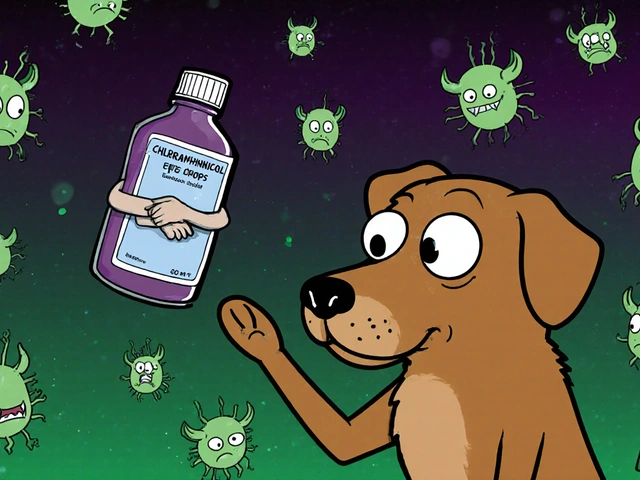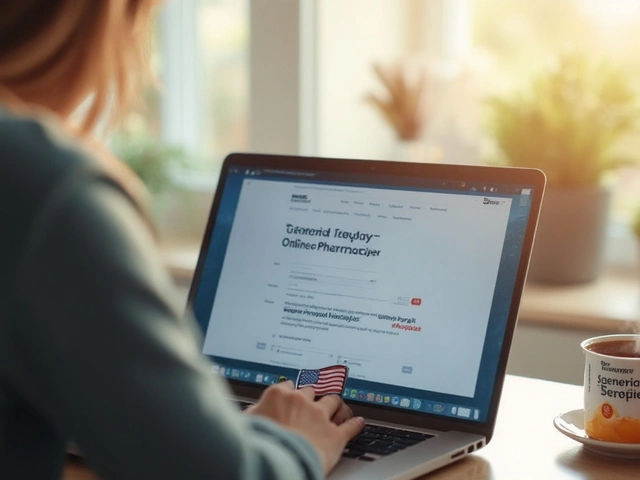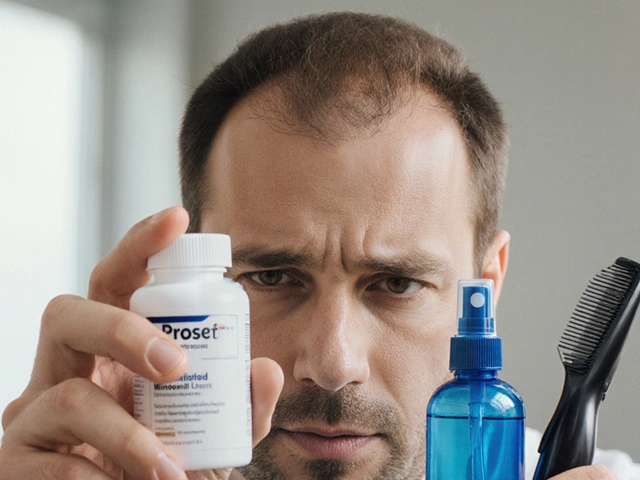When your dog keeps rubbing their eye or your cat is squinting with watery discharge, it’s natural to panic. Eye infections in pets are common, but they’re not always harmless. Left untreated, they can lead to corneal ulcers, scarring, or even vision loss. One of the most trusted antibiotics for these cases is chloramphenicol - a broad-spectrum drug that’s been used in veterinary medicine for decades. But here’s the thing: just because it’s available doesn’t mean it’s safe to use without a vet’s direction.
What Is Chloramphenicol and How Does It Work?
Chloramphenicol is a broad-spectrum antibiotic that stops bacteria from making proteins they need to survive. It works against both gram-positive and gram-negative bacteria - the two main types that cause eye infections in pets. That’s why it’s often prescribed for conjunctivitis, corneal ulcers, and blepharitis in dogs and cats.
It’s not a new drug. Chloramphenicol was first synthesized in 1947 and became widely used in human medicine before being adapted for animals. In veterinary practice, it’s most commonly found in topical eye drops or ointments. The concentration in pet formulations is usually 0.5% to 1%, which is strong enough to kill bacteria but gentle enough for delicate eye tissue.
What makes chloramphenicol useful for pets is its ability to penetrate eye tissues effectively. Many antibiotics can’t reach deep enough into the cornea or conjunctiva, but chloramphenicol does. It’s also relatively inexpensive compared to newer alternatives, which is why many vets still reach for it - especially in cases where cost matters.
Common Eye Infections in Dogs and Cats
Not every red or watery eye is the same. Here are the most frequent infections treated with chloramphenicol:
- Conjunctivitis: Inflammation of the pink tissue around the eye. Often caused by bacteria like Staphylococcus or Streptococcus. Symptoms include redness, swelling, and thick discharge - sometimes yellow or green.
- Corneal ulcers: Open sores on the surface of the eye. These can be caused by scratches, foreign objects, or dry eye. Bacteria can invade the wound, leading to secondary infection. Chloramphenicol helps prevent the infection from spreading deeper.
- Blepharitis: Inflammation of the eyelids. Often linked to bacterial overgrowth or allergies. Chloramphenicol ointment applied along the eyelid margin can reduce swelling and clear up crusty buildup.
- Keratitis: Inflammation of the cornea. Can be bacterial, viral, or autoimmune. Chloramphenicol is used when bacteria are the main concern.
These infections aren’t just annoying - they’re painful. Pets may paw at their eyes, avoid light, or blink more than usual. If you notice any of these signs, don’t wait. Early treatment stops complications.
Why Veterinarians Choose Chloramphenicol Over Other Options
You might wonder: why not use something newer, like ciprofloxacin or tobramycin? Those are also effective. But chloramphenicol still holds its ground for several reasons.
First, it’s effective against a wider range of bacteria than many newer eye drops. For example, Pseudomonas aeruginosa - a tough bug that causes severe corneal infections - is often resistant to common antibiotics. Chloramphenicol still works against many strains.
Second, it’s well-tolerated by most pets. Unlike some antibiotics that cause stinging or irritation, chloramphenicol eye drops are generally gentle. Cats, in particular, don’t tend to resist application as much with this formulation.
Third, it’s affordable. A 5ml bottle of chloramphenicol eye drops costs around £10-£15 in the UK, while branded alternatives like Vigamox can run over £40. For pet owners managing multiple animals or on a tight budget, that difference matters.
That said, chloramphenicol isn’t always the first choice. Some vets now prefer fluoroquinolones for suspected Pseudomonas cases because resistance to chloramphenicol is rising in some areas. But for routine bacterial infections - especially in small clinics or rural areas - chloramphenicol remains a reliable workhorse.
How to Use Chloramphenicol Correctly
Using eye medication on a pet isn’t as simple as putting a drop in. Here’s how to do it right:
- Wash your hands. Always. Bacteria from your skin can make the infection worse.
- Restrain your pet gently. Have someone hold your dog or cat while you apply the drops. Don’t force it - stress can make them more resistant next time.
- Position the head. Tilt the head slightly upward. For cats, you may need to gently pull down the lower eyelid to create a pocket.
- Apply the dose. Hold the dropper or tube above the eye, not touching it. One drop or a 1/4 inch strip of ointment is usually enough. Avoid squeezing the tube directly onto the eye.
- Let them blink. Don’t rub the eye. Let your pet blink naturally to spread the medication.
- Wait 5 minutes. If you’re using another eye product, wait at least 5 minutes before applying the next one.
- Finish the full course. Even if the eye looks better in 2 days, keep using it for the full 7-10 days. Stopping early can cause resistant bacteria to grow back.
Store the bottle in the fridge after opening. Most chloramphenicol eye drops lose potency after 30 days, even if refrigerated. Always check the expiration date on the label.

Side Effects and Risks
Chloramphenicol is generally safe for short-term topical use in pets. But there are risks you can’t ignore.
Topical use rarely causes serious side effects. The most common is mild irritation - stinging, redness, or increased tearing right after application. This usually goes away in minutes.
But here’s the big one: systemic absorption. If your pet licks the ointment off their paw or face, they can swallow it. While small amounts from eye drops are unlikely to cause harm, repeated ingestion - especially in small dogs or cats - can lead to bone marrow suppression. This is rare, but it’s deadly when it happens.
Signs of bone marrow problems include pale gums, lethargy, vomiting, and unexplained bruising. If your pet shows any of these after using chloramphenicol, stop the medication and call your vet immediately.
Also, never use human chloramphenicol eye drops on your pet. The concentration or preservatives may be different. Only use veterinary-formulated products.
When NOT to Use Chloramphenicol
Chloramphenicol isn’t a cure-all. Avoid it if:
- The infection is viral (like feline herpesvirus). Antibiotics won’t help - antivirals like famciclovir will.
- Your pet has a known allergy to chloramphenicol or similar antibiotics.
- The eye injury is deep or involves the eyeball itself (like a perforated cornea). These need specialist care.
- Your pet is pregnant, nursing, or very young. The risk of bone marrow suppression is higher in these cases.
- You’ve used chloramphenicol before and the infection came back. This could mean resistant bacteria are present.
If you’re unsure, get a culture. Many vets now offer conjunctival swabs to identify the exact bacteria causing the infection. That way, they can pick the most targeted antibiotic - not just guess.
Alternatives to Chloramphenicol
If chloramphenicol isn’t right for your pet, here are other options your vet might suggest:
| Antibiotic | Best For | Pros | Cons |
|---|---|---|---|
| Chloramphenicol | Broad-spectrum bacterial infections | Effective against many bacteria, low cost, well-tolerated | Risk of bone marrow suppression if ingested, rising resistance |
| Ciprofloxacin | Pseudomonas, severe ulcers | Strong against tough bacteria, fast-acting | More expensive, can cause irritation in some cats |
| Tobramycin | Gram-negative infections | Good for Pseudomonas, low toxicity | Less effective against gram-positive bacteria |
| Neomycin/Polymyxin B | Mild conjunctivitis | Safe for long-term use, widely available | Higher risk of allergic reactions |
| Terramycin (Oxytetracycline) | Chlamydia, chronic infections | Good for long-term cases, affordable | Less potent than newer options |
Many vets now combine antibiotics with anti-inflammatories like prednisolone - but only if there’s no ulcer. Steroids can make ulcers worse. That’s why diagnosis matters.

Prevention Tips for Pet Eye Health
The best treatment is no treatment at all. Here’s how to reduce the chance of eye infections:
- Keep long hair trimmed around the eyes - especially in breeds like Shih Tzus or Persians.
- Wipe away discharge daily with a clean, damp cloth.
- Avoid letting your dog stick their head out the car window. Dust and debris get in fast.
- Check for foreign objects after walks - grass seeds are a common culprit.
- Use a humidifier in dry winter months. Dry air can cause irritation and secondary infections.
- For cats with recurring herpesvirus, consider lysine supplements (though evidence is mixed).
Regular vet checkups catch problems early. A simple eye exam takes less than 5 minutes but can prevent months of discomfort.
Frequently Asked Questions
Can I use human chloramphenicol eye drops on my dog or cat?
No. Human eye drops may contain preservatives or concentrations that aren’t safe for pets. Some formulations include benzalkonium chloride, which can damage the cornea in animals. Always use veterinary-approved chloramphenicol products.
How long does it take for chloramphenicol to work on a pet’s eye infection?
Most pets show improvement within 2-3 days. Redness and discharge should start to clear up. But don’t stop treatment early - even if the eye looks fine. Full course is usually 7-10 days to ensure the infection is completely gone.
Is chloramphenicol safe for kittens and puppies?
Topical use is generally safe for young pets, but they’re more vulnerable to accidental ingestion. Kittens and small puppies have smaller bodies, so even a small amount swallowed can pose a risk. Always supervise application and prevent licking. If in doubt, ask your vet for a safer alternative.
Can chloramphenicol cause blindness in pets?
Not when used correctly. But if an infection is left untreated or if the wrong medication is used (like steroids on an ulcer), blindness can occur. Chloramphenicol itself doesn’t cause blindness - but delaying proper treatment does.
Why does my vet want a culture before prescribing chloramphenicol?
Bacteria are becoming resistant to chloramphenicol in some areas. A culture identifies the exact bacteria causing the infection and tests which antibiotics it’s sensitive to. This means your pet gets the right drug the first time - no trial and error.
What should I do if my pet refuses to take the eye drops?
Try wrapping your pet in a towel like a burrito to limit movement. Use treats before and after to create positive associations. If they’re still resistant, ask your vet about ointments - they’re easier to apply and last longer. Some vets also offer compounded formulations with flavoring to reduce stress.
Final Thoughts
Chloramphenicol is a powerful tool for treating bacterial eye infections in pets. It’s affordable, effective, and has stood the test of time. But it’s not a magic bullet. Misuse - especially self-prescribing or skipping the vet - can lead to serious problems. Always get a proper diagnosis. Follow the full course. Watch for side effects. And remember: an eye infection might look minor, but in pets, it’s often a sign something deeper is wrong. Don’t wait. Act fast, but act wisely.







Theresa Ordonda
October 31, 2025 AT 04:47Judy Schumacher
October 31, 2025 AT 06:53Anthony Griek
October 31, 2025 AT 13:33Norman Rexford
November 1, 2025 AT 22:13Wayne Keller
November 3, 2025 AT 12:20chantall meyer
November 5, 2025 AT 12:11Lorne Wellington
November 5, 2025 AT 22:15Will RD
November 7, 2025 AT 01:50Jacqueline Anwar
November 7, 2025 AT 03:01Ganesh Kamble
November 9, 2025 AT 02:25Jenni Waugh
November 9, 2025 AT 23:02